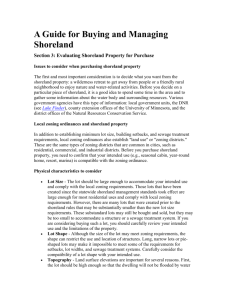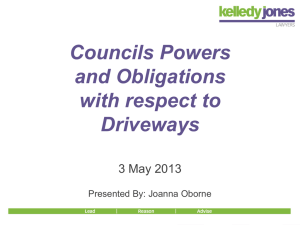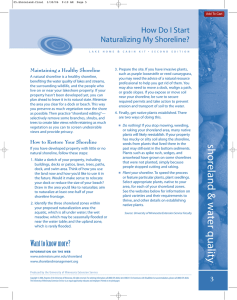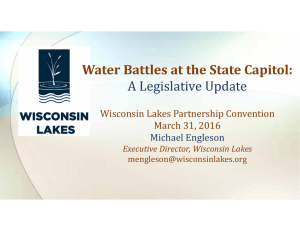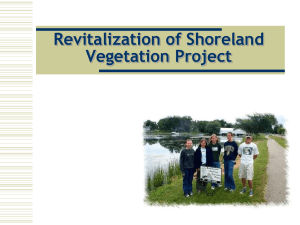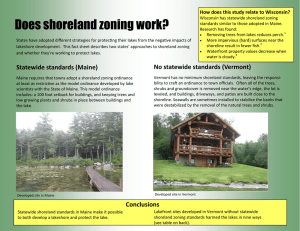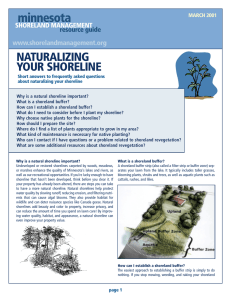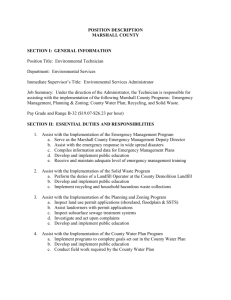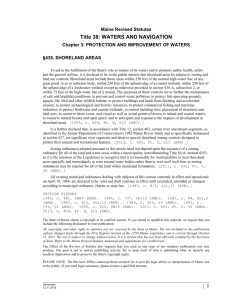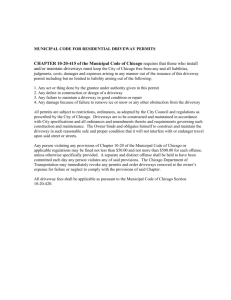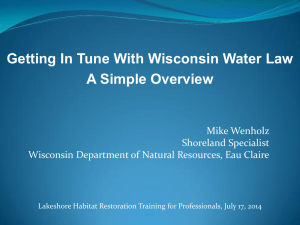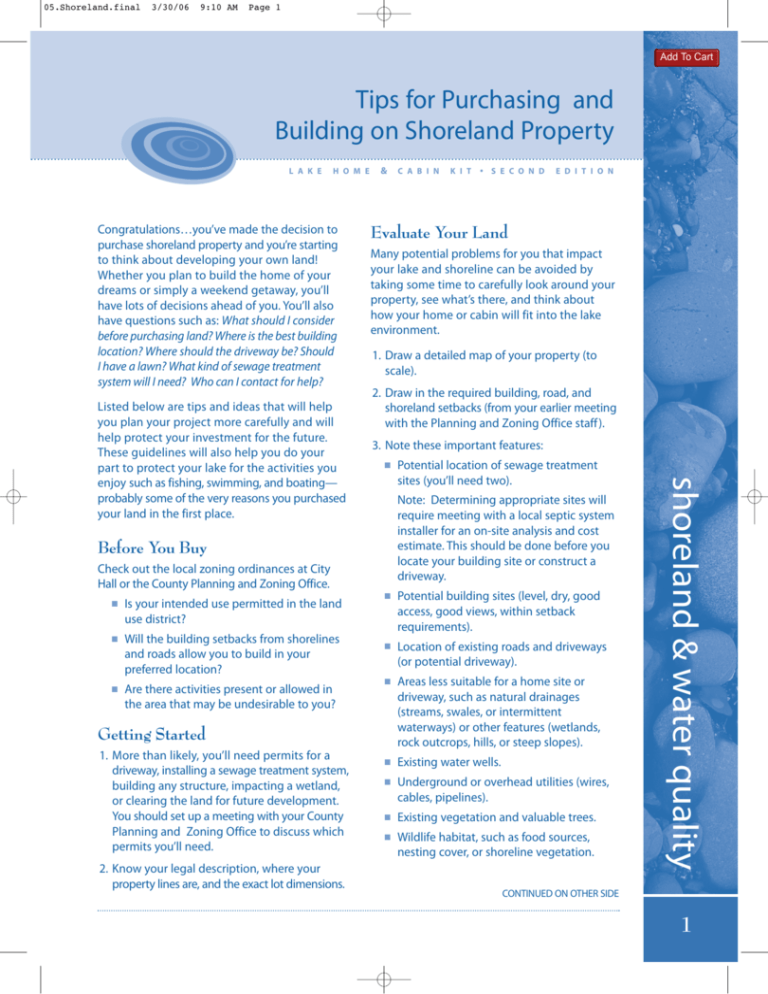
05.Shoreland.final
3/30/06
9:10 AM
Page 1
Add To Cart
Tips for Purchasing and
Building on Shoreland Property
L A K E
H O M E
Congratulations…you’ve made the decision to
purchase shoreland property and you’re starting
to think about developing your own land!
Whether you plan to build the home of your
dreams or simply a weekend getaway, you’ll
have lots of decisions ahead of you. You’ll also
have questions such as: What should I consider
before purchasing land? Where is the best building
location? Where should the driveway be? Should
I have a lawn? What kind of sewage treatment
system will I need? Who can I contact for help?
■
Will the building setbacks from shorelines
and roads allow you to build in your
preferred location?
■
Are there activities present or allowed in
the area that may be undesirable to you?
2. Know your legal description, where your
property lines are, and the exact lot dimensions.
E D I T I O N
1. Draw a detailed map of your property (to
scale).
2. Draw in the required building, road, and
shoreland setbacks (from your earlier meeting
with the Planning and Zoning Office staff ).
3. Note these important features:
■
Potential location of sewage treatment
sites (you’ll need two).
Note: Determining appropriate sites will
require meeting with a local septic system
installer for an on-site analysis and cost
estimate. This should be done before you
locate your building site or construct a
driveway.
■
Potential building sites (level, dry, good
access, good views, within setback
requirements).
■
Location of existing roads and driveways
(or potential driveway).
■
Areas less suitable for a home site or
driveway, such as natural drainages
(streams, swales, or intermittent
waterways) or other features (wetlands,
rock outcrops, hills, or steep slopes).
■
Existing water wells.
■
Underground or overhead utilities (wires,
cables, pipelines).
■
Existing vegetation and valuable trees.
■
Wildlife habitat, such as food sources,
nesting cover, or shoreline vegetation.
Getting Started
1. More than likely, you’ll need permits for a
driveway, installing a sewage treatment system,
building any structure, impacting a wetland,
or clearing the land for future development.
You should set up a meeting with your County
Planning and Zoning Office to discuss which
permits you’ll need.
• S E C O N D
Many potential problems for you that impact
your lake and shoreline can be avoided by
taking some time to carefully look around your
property, see what’s there, and think about
how your home or cabin will fit into the lake
environment.
Check out the local zoning ordinances at City
Hall or the County Planning and Zoning Office.
Is your intended use permitted in the land
use district?
K I T
Evaluate Your Land
Before You Buy
■
C A B I N
shoreland & water quality
Listed below are tips and ideas that will help
you plan your project more carefully and will
help protect your investment for the future.
These guidelines will also help you do your
part to protect your lake for the activities you
enjoy such as fishing, swimming, and boating—
probably some of the very reasons you purchased
your land in the first place.
&
CONTINUED ON OTHER SIDE
1
05.Shoreland.final
3/30/06
9:10 AM
Page 2
Tips for Purchasing and Building
on Shoreland Property continued
L A K E
H O M E
&
C A B I N
K I T
• S E C O N D
4. Find out if utilities are available at the site
and check with the local utility companies for
service requirements—electricity, sewage,
phone, etc.
5. Meet with a well driller to determine your
options for drinking water.
E D I T I O N
4. Minimize hard surfaces, such as driveways, so
rain can infiltrate naturally into the ground.
Direct runoff to vegetated areas and consider
developing a rain garden to treat runoff and
add beauty to your property. Read the “How
Can I Create a Rain Garden?” fact sheet.
6. If you have an existing well, have the water
tested to evaluate quality for problems such
as harmful bacteria or nitrates (see the “How
Do I Test My Drinking Water?” fact sheet).
Other Tips
Construction
2. Consider limiting the amount of lawn on your
property. Native vegetation doesn’t require
expensive landscaping and will require less
maintenance while enhancing aesthetics,
wildlife habitat, and water quality. See the
“How Can I Maintain a Healthy Lawn on My
Lakeshore?” fact sheet for any lawn that you
do have.
1. Plan roads and driveways to follow the
contours of the land to keep the driveway
as level as possible and minimize erosion.
Avoiding steep slopes, wetland areas, and
natural watercourses will result in a safer
road with less negative impact to natural
resources. Remember to leave room for snow
removal, and think about how you’ll get into
and out of your driveway in slippery
conditions.
2. Make sure your contractor develops and
follows an erosion and sediment control plan
to minimize the harmful effects of sediment
(or dirt) leaving your site.
3. To avoid soil compaction and damage to
vegetation, flag areas that need to be offlimits to construction equipment such as
sewage treatment systems, natural watercourses, trees, and wetlands. Read the “How
Can I Protect My Trees from Construction
Damage?” fact sheet.
Want to know more?
INFORMATION ON THE WEB
1. Fire Protection—Plan your driveway and
turn-around to meet minimum access
requirements for emergency vehicles.
3. Retain natural vegetation within the
Shoreland Impact Zone along your lake or
river. Your county Planning and Zoning
Office can provide you with the shoreland
ordinances that have specific instructions
on how to maintain this zone. Dead trees
that have fallen in the water should be left
in place because they can reduce shoreline
erosion and provide habitat for fish and
wildlife. To provide view corridors from
windows and decks, selected trees can be
removed or branches can be trimmed. More
information on natural vegetation can be
found in the “Why Should I Choose Native
Plants for My Shoreline?” fact sheet.
4. Take care of your septic system: Read all the
fact sheets on care and maintenance.
Source: University of Minnesota Extension Service Faculty.
For additional tips and ideas on developing your property, visit:
www.lakesuperiorstreams.org.
Minnesota Shoreland Management Resource Guide
www.shorelandmanagement.org
Produced by the University of Minnesota Extension Service
Copyright © 2006, Regents of the University of Minnesota. All rights reserved. For ordering information call (800) 876-8636, item #08241. For Americans with Disabilities Act accommodations, please call (800) 876-8636.
The University of Minnesota Extension Service is an equal opportunity educator and employer. Printed on recycled paper.
1a


